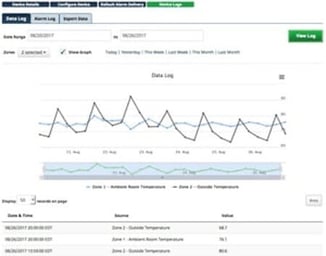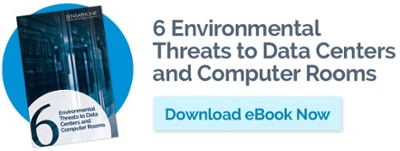
Data loggers play an important role in various industries by remotely monitoring environmental conditions like temperature and humidity in areas that are either remote or unattended most or part of the time. Data loggers help ensure important equipment continues to operate, which in turn helps maintain product quality and comply with regulatory standards.
As technology has advanced, data loggers have become more sophisticated. The Industrial Internet of Things (IIOT) technology, which underpins the Sensaphone system, has revolutionized data collection and logging. In the past, workers had to visit sites to connect to legacy devices, retrieve data logs and manually download data, which were tedious and time-consuming tasks.
Cloud-based Data Logging Operations
Today’s data loggers are cloud-based devices that can track a wide range of conditions. For instance, data loggers can monitor the temperature in server rooms, humidity levels in greenhouses and farms, and the precise temperature inside food and beverage storage freezers. If any conditions exceed specific limits, the system can send alarm notifications, prompting operators to take immediate action.
Operators can access this data in real time from anywhere in the world on their phones, laptops or desktops to remotely oversee environments and ensure the stability of operations.
These systems collect data from sensors and transmit it to a secure cloud platform. This data is useful for meeting compliance standards and supporting audit trails and reporting.
Here's how it works: Sensors are placed in areas that need to be monitored. They are then wired to the data logger, which is typically mounted on a wall at the facility.
Traditional data loggers supported only one or two sensors. However, cloud-based systems like the Sentinel support up to 12 sensors for monitoring a range of conditions.
Once connected, the device gathers data and saves the readings to the cloud. With traditional data loggers, personnel had to manually upload the data to computers for viewing and reporting. With cloud-based systems, they can quickly access data through a web-based interface.
Alarm Notification
In the event of an abnormal condition, Sentinel data loggers can notify an unlimited number of contacts through calls, texts or emails.
Configuring these alarms is fast and easy. Users log into the Sensaphone app or website to define the desired conditions. With real-time alerts and status updates, users can rest assured that their assets are protected and their equipment is functioning optimally. While the Sentinel is in alarm, it can also be programmed to log data at a more rapid interval.
Sensor Options
The Sentinel can connect to up to 12 sensors, enabling it to monitor different assets simultaneously, such as multiple refrigerators and freezers in a hospital.
Using a 4-20mA sensor for data logging can provide valuable insights into various site operations. This includes tracking the power usage of pumps, measuring levels in well or gas tanks and monitoring water pressure. It can even log extreme temperatures in furnaces or ultralow-temperature freezers. Essentially, these sensors are equipped to oversee nearly any operation.
Sentinel Pro monitoring systems can also extract data from existing control systems, making it accessible remotely. Users can also monitor and log data from programmable logic controllers and existing building automation systems.
Applications for Data Logging
Cloud-based data loggers are essential tools for monitoring various assets across different industries. They provide real-time access to performance data and can store and report data to demonstrate equipment and product performance over time.
Additionally, analyzing trends and comparing data log records can help identify potential problems that may impact the quality of operations and products. This information also is essential for demonstrating compliance in certain industries.
Ensure Safe Medical Supplies
Hospitals, blood banks, pharmacies, labs and clinics can use data loggers to monitor the temperature of critical and costly items like vaccines, blood supplies, tissue samples and medicines.
For example, whole blood needs to be kept at at 1 to 6 °C (34 to 43 °F), while fresh-frozen plasma should be stored at -18 °C (-0.4 °F) or colder. It’s alarming that nearly 50% of vaccines are wasted every year globally, as reported by the World Health Organization, mainly due to temperature control and logistical challenges.
Data logging is often mandated by state and federal health departments like the CDC, VFC, FDA and FED, which oversee facilities like vaccine storage areas, food and beverage plants, and marijuana growing operations.
These organizations require that data is stored and accessible at all times for state or federal inspectors who audit these facilities. Data log records verify that product temperatures remained within accepted health ranges from the time of manufacture or growth until arrival at the point of sale.
Without proper data validation, the facility is held accountable and may have to dispose of any potentially compromised products.

Validate Environmental Compliance
The EPA requires water and wastewater facilities to maintain records of water meters, pH levels, and maximum flow totals for effluent for at least three years. The samples collected for compliance reporting will determine if facilities are within their discharge limits and confirm that the effluent is safe to reintroduce into the environment. This practice helps prevent hefty fines or shutdowns.Growing and Farming
Data logging can be beneficial even when it is not a requirement. For example, a greenhouse grower can use data to understand the reasons behind a decrease in crop production.
By comparing temperatures, CO2 levels, humidity or soil moisture from year to year, the grower can identify the optimum growing conditions for the plants. This information allows fine-tuning the environment, ultimately increasing plant production and health, and maximizing yield season after season.
Clean Air and Energy Savings
Data centers, universities, hospitals and hotels can use data logging to improve the efficiency of HVAC (heating, ventilation and air conditioning) equipment. This process helps:- Identify varying heat and cool patterns throughout the day.
- Reveal whether an air conditioning unit is under- or oversized, which could lead to significant waste in cooling costs.
- Determine if it takes longer than usual to cool the environment, indicating a potential need for maintenance.

Choosing a Data Logger
When looking for a data logger, keep the following in mind in relation to the size of your operation and your specific monitoring and logging needs.- Flexible communication methods - Determine whether you require a standard Ethernet connection, Wi-Fi or a cellular connection to communicate your data and send alarms. Modern systems are easy to install without IT assistance. Ideally, you should be able to plug the device into a live internet connection (via Ethernet, Wi-Fi or cellular service) and have it start working immediately.
- Cloud storage – Cloud service provides unlimited data and event logging for safe, secure information storage. When your data is sent to a cloud server, you can access it by creating an account to manage your monitoring device(s). Unlike non-cloud-based systems, which store data internally and overwrite older information, cloud-based solutions securely retain your data.
- Self-monitoring – Cloud-based monitoring systems are self-supervising, which means the system can alert you if it fails to connect. If the communication link is interrupted, these systems generate an alarm indicating a lost internet connection or cellular communications issue. For example, disruptions could occur due to a power outage or someone accidentally turning off the unit. In such cases, users receive alerts via phone, text or email.
- Management of multiple devices – If you anticipate a facility expansion, ensure you can add as many monitoring/logging devices to your account as needed. It’s possible to manage hundreds of devices from one account, with data from each device viewable from one dashboard.
- Mobile app – Mobile access allows you to manage your monitoring system and check data from your phone or tablet. This provides a quick and convenient way to access trending reports, inspect the status of specific equipment, and review alarm history.
- Report generation – Ideally, the system should enable you to view the entire facility’s performance from anywhere at a moment’s notice. Additionally, it should generate custom reports as a PDF, CSV or text document, based on the predefined conditions and intervals that you set.
All cloud- and network-based Sensaphone models can serve as data loggers, including the Sentinel product line, WEB600, WSG30, IMS-4000 Enterprise system and IMS-1000. Find our more American-made SENSAPHONE remote monitoring Solutions or contact our sales team.








